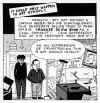 Dan
Clowes from Art School Confidential
Dan
Clowes from Art School ConfidentialCritiques
 Dan
Clowes from Art School Confidential
Dan
Clowes from Art School Confidential
The purpose of a critique is to
help you learn to create better imagery. A critique is not meant to be a
put-down of your work, but a tool to help you better see your work and develop
your own critical eye when it comes to your projects. When others point out a
technical problem, or give suggestions to improve your work, this is invaluable
information for you. You don’t have to agree with the comments made, but
listening to evaluations of your work can give you valuable insights to increase
your skills.
Critiquing is not meant to be a
put-down of someone’s work. Telling someone simply you do not like the work
does not give the person you review any information, other than a rude opinion.
It does not give you anything of value either. Thinking how the work could be
better and communicating the information makes you think and formulate an eye
for details that will help in your own work. By discussing a critique openly
with the artist and others who are critiquing the same work everyone learns from
it. The more information you exchange the better the critique.
Reviewing
other’s work is a valuable learning tool. You begin to focus in on details
that you see in someone’s work. A task that is easier in most cases, when you
are viewing work other than your own.
Suggestions
for Critiques
1. Speak directly to the person who made the work.
Find one thing you like about the work. Be positive: we are trying to use
positive reinforcement. It doesn't have to be profound or lengthy, but you must
say it directly to the person who made the work: "My eye really seems to be
drawn to this little squiggly shape up in the corner: It’s interesting to me
that such a little shape can be such a strong part of your picture.”
2. Express honest feelings.
OK, but you don't have to say everything you are thinking. Again, we are seeking
to reinforce the things we've done right. Think about it: if you wear something
new, and people compliment you, are you likely to wear it again? The same thing
goes for art. In the critique, we learn about what we did right, and that can
help on the next project. So, if you don't like the shape on the right, but you
like the squiggle on the left, comment on the squiggle.
3. Stay aware of your thoughts and feelings.
Your feelings are yours. Don't allow yourself to be swayed by others into
thinking that what you feel isn't valid. Art is always open to interpretation,
and you may learn something that will change your mind about the art you're
looking at, but what you think and feel should be the starting point for your
analysis. Be open to what others are saying, but always be yourself.
4. Learn from each discussion
-how can you apply this to your work? In art, we learn by doing, then reflecting
on what we have done. Seeing our work through other people's eyes is one of the
most valuable things we can do.
5. Use constructive criticism.
If you offer criticism, remember how you would like to hear it. Start by
pointing out what's right before you offer suggestions. "I think that great
squiggle up in the corner of your picture might be even more effective if the
shape on the right were a little smaller: What do you think?” An open dialogue
feels less threatening than if you just make pronouncements about their work.
BEAR
IN MIND THE PURPOSE OF CRITIQUE. Anyone can
criticize. An artist seeks another artist's opinion for advice on making their
work better.
ASK
QUESTIONS. If the imagery loses you at any
point, ask the artist questions. Let the artist know when you're confused. Let
the artist know when you're curious.
Don't just say "I like it" or "I don’t like it." Even if
the piece is so perfect it deserves to be hung in a museum in its present form,
you can still identify the elements of design and offer feedback about how you
felt as you looked at the piece.
"Giving
Critique - a Check List for Critiquers"
Henrik
Lindberg
There
are two checklists: a positive list for the elements that contribute to a
successful work; and a negative list that looks at flaws.
 Positive
Check List
Positive
Check List
 Negative
Check List
Negative
Check List
How to give critique
Your
critique should be divided into two sections: what has been done well and what
could be improved. The focus should be on providing feedback that will help the
artist - and onlookers - learn something.
What
has been done well
- select a few of the best things and say why you think they work.
What
could be improved
– select areas where the biggest improvements could be made and say why.
Suggest ways the improvements could be made and give your reasons. Where
appropriate, provide links to relevant examples or reference material. If the
artist has chosen to allow digital alternations of their work you may like to
provide an edited image to illustrate your points.
Don't
Do
Remember,
the artist is seeking constructive feedback on how to improve - both in the work
under critique and for their future development. Therefore, your suggested
improvements do not have to be corrections that can be easily made. For example,
it may not be possible to completely rearrange a watercolor but the artist can
incorporate what is learned in future work.
When
the artwork is exceptionally good, and you can not find any improvements you can
instead elaborate on the analysis and point out in more detail what has been
done well - this could be more for the benefit of the onlookers than for the
artist.
Finally,
when giving a critique, try to think of yourself as being hired by the artist as
a mentor or teacher, or perhaps a defense attorney whose job is to make your
client's work look its best in court (even if it is hideous). If you truly
dislike something and really can’t think of anything that would help, it is
best to refrain from posting. If the artist has specifically asked for your
opinion, perhaps, instead of a critique, you could suggest some exercises,
articles, other artwork or reference material to look at. Remember there are
plenty of lessons, projects, library images and other material here at WetCanvas!
to refer to.